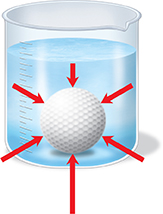13.3 Buoyancy
Reading Focus
Key Concepts
 What is the effect of buoyancy on the apparent weight of an object?
What is the effect of buoyancy on the apparent weight of an object? How can you determine if an object will float or sink in a fluid?
How can you determine if an object will float or sink in a fluid?
Vocabulary
buoyancy
buoyant force
Archimedes' principle
Reading Strategy
Summarizing Copy the table below. As you read about buoyancy, write a brief summary of the text following each green heading. Your summary should include only the most important information.
Section 13.3 Buoyancy
Buoyant Force Buoyant force is the apparent loss of weight of an object submerged in a fluid.
a. 
b. 

Figure 10 The forces from pressure acting on the bottom of this golf ball are greater than those acting on the top. This produces a net force—called the buoyant force—that acts upward on the ball.
Image spans to next page
Have you ever stood in a pool and tried lifting a friend who was submerged in the water? If you have, you may recall how surprisingly easy your friend was to lift. Or perhaps you have gone swimming in a lake or bay where the very salty water made it easy to float on the surface. What forces make these two situations possible? In this section you'll learn the answers to these questions.
Buoyant Force
You are easily able to lift a friend submerged in water because of buoyancy. Buoyancy is the ability of a fluid to exert an upward force on an object placed in it.  Buoyancy results in the apparent loss of weight of an object in a fluid. In fact, every object in a fluid experiences buoyancy. When an object is submerged in water, the water exerts an upward force on the object, making it easier to lift. This upward force, which acts in the opposite direction of gravity, is called a buoyant force.
Buoyancy results in the apparent loss of weight of an object in a fluid. In fact, every object in a fluid experiences buoyancy. When an object is submerged in water, the water exerts an upward force on the object, making it easier to lift. This upward force, which acts in the opposite direction of gravity, is called a buoyant force.
How is a buoyant force produced? To answer this question, examine the forces pressure exert on the submerged object in Figure 10. Because water pressure increases with depth, the forces pushing up on the bottom of the object are greater than the forces from pressure pushing down on the top of the object. All of the other non-vertical forces cancel one another out. The result is a net upward force—the buoyant force.




